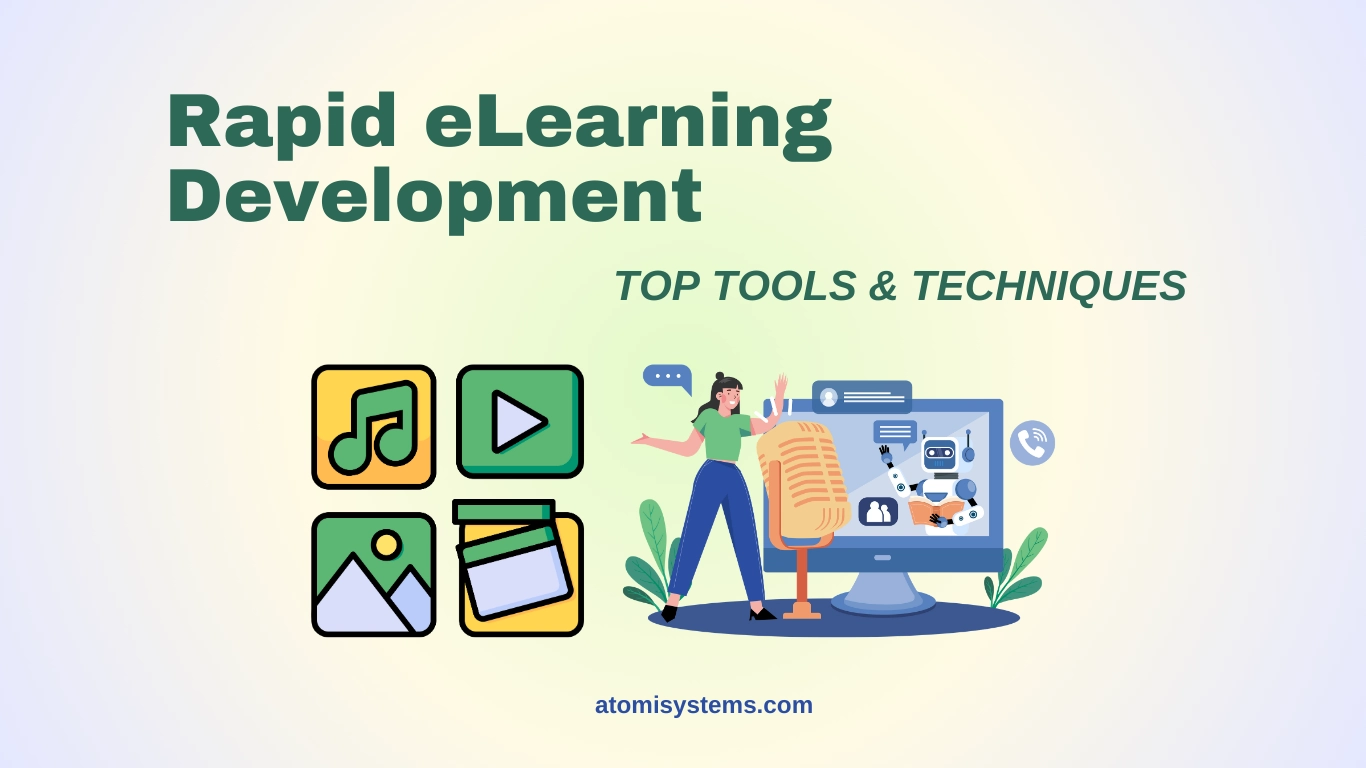Rapid eLearning Development: Top Tools and Techniques for 2024
In today’s fast-paced world, companies, and educational institutions are increasingly turning to rapid eLearning development to create training content that keeps up with the evolving needs of learners. Traditional eLearning approaches, while effective, can be time-consuming and resource-intensive. Rapid eLearning, on the other hand, uses agile methodologies and innovative tools to streamline course creation, allowing instructional designers to produce quality content quickly and efficiently. In this post, we’ll recap some of the best tools and techniques for rapid eLearning development in 2024 and provide actionable insights into how they can transform your content creation process.

What is Rapid eLearning Development?
Rapid eLearning development is a method of creating learning content quickly using efficient tools and workflows. This approach leverages pre-built templates, reusable content, authoring tools, and often minimal instructional design to get courses out to learners as quickly as possible. Unlike traditional eLearning, which may involve months of planning and execution, rapid eLearning development can reduce production time to weeks or even days, depending on the complexity of the material.
Rapid eLearning is especially useful in corporate training, where changes happen quickly, and employees need to adapt to new skills or knowledge without delay. In 2024, rapid eLearning is not just a trend; it’s becoming a necessity, as businesses face an unprecedented need for upskilling and reskilling to maintain a competitive edge.
Top Tools for Rapid eLearning Development in 2024 & 2025
Selecting the right tools is crucial for successful rapid eLearning development. Here are some of the best tools currently available for efficient, high-quality content creation:
Articulate 360
Articulate 360 is a comprehensive eLearning suite that includes Storyline 360, Rise 360, and other tools specifically designed for rapid content creation. Storyline 360 is particularly useful for building interactive courses with advanced functionalities, while Rise 360 allows for the creation of responsive, mobile-friendly content with minimal effort.
Key Features
– Pre-built templates and content blocks
– Interactive elements like quizzes, sliders, and branching scenarios
– Responsive design across devices
– Easy sharing and collaboration
Articulate 360’s intuitive interface and wide range of customizable templates make it ideal for both beginner and experienced instructional designers looking to create engaging courses quickly.
ActivePresenter
ActivePresenter by Atomi Systems is a versatile eLearning tool integrating screen recorder and feature-rich video editor, which is ideal for creating interactive training videos, simulations, and eLearning courses. It’s particularly popular for creating screencasts and software simulations, making it a great choice for rapid eLearning content that requires both video and interactive elements.
Key Features
– Screen recording and interactive content creation
– Built-in audio and video editing tools
– HTML5 export for SCORM-compliant courses
– Templates for easy, quick content customization
ActivePresenter’s ability to seamlessly integrate video with interactive quizzes and simulations makes it highly useful for technical training and complex eLearning projects. Its intuitive interface and wide range of export options make it accessible to both novice and experienced instructional designers.
You can download the app and try all the features for free without any restrictions:

Adobe Captivate
Adobe Captivate is known for its robust functionality, supporting everything from simple presentations to VR (virtual reality) content. In 2024, Adobe Captivate continues to be a favorite among instructional designers due to its versatility and mobile compatibility.
Key Features
– Responsive projects for multi-device learning
– VR learning experiences and 360-degree media support
– Advanced triggers and scripting for complex interactions
– Integrates with Adobe Creative Cloud
Captivate’s ability to create immersive experiences through VR and its extensive features make it a valuable tool for those looking to add depth to their rapid eLearning projects.
iSpring Suite
iSpring Suite is a popular choice for organizations looking to convert PowerPoint presentations into engaging eLearning courses. It offers an intuitive interface and a range of features to enhance traditional presentations with quizzes, video lectures, and interactive elements.
Key Features
– Easy PowerPoint integration
– Supports quizzes, surveys, and video lectures
– SCORM-compliant output
– Responsive design for mobile learning
iSpring’s ease of use and PowerPoint integration make it perfect for companies looking to create high-quality courses from existing content without a steep learning curve.
uPresenter
uPresenter is an innovative cloud-based authoring tool designed to speed up eLearning development by enabling easy team collaboration and offering a wide range of customization options. uPresenter’s user-friendly interface, combined with powerful features, supports efficient creation of SCORM and xAPI-compliant courses that can be accessed across different devices.
Key Features
– Cloud-based platform for real-time collaboration
– Extensive library of customizable templates and interactive elements
– Easy-to-use drag-and-drop editor
– Compatibility with SCORM, xAPI, and other LMS standards
With its strong collaboration capabilities, uPresenter is ideal for teams working on rapid eLearning projects. The platform’s robust templates and intuitive editor make it simple to design engaging courses quickly without sacrificing quality.

Effective Techniques for Rapid eLearning Development
In addition to selecting the right tools, employing efficient techniques can significantly speed up the course creation process. Here are some key techniques to implement in 2024:
Storyboarding and Prototyping
Storyboarding and prototyping can streamline content development by providing a clear structure and vision for the course before development begins. This technique allows stakeholders to review and approve the flow and structure, reducing the likelihood of major revisions later in the process.
Reusable Learning Objects (RLOs)
Reusable Learning Objects (RLOs) are self-contained content modules that can be reused across different courses. By creating modules like quizzes, videos, or interaction templates that can be repurposed, instructional designers can significantly reduce development time.
Microlearning Modules
Breaking down content into smaller, focused microlearning modules can make it easier and faster to produce while enhancing learner engagement. Microlearning is also more likely to be retained by learners, making it a win-win for both learners and developers.
Rapid Prototyping and Iterative Development
The rapid prototyping technique involves creating a basic version of the course, gathering feedback, and then improving the content in multiple iterations. This agile approach allows for adjustments and improvements without delaying the overall project timeline.
Automation and AI-Powered Tools
Using automation and AI-driven tools can dramatically speed up repetitive tasks, like formatting content or generating assessments. Tools like ChatGPT, for instance, can assist in drafting content or generating quiz questions, while AI-based platforms can adjust learning paths automatically.
Collaboration and Feedback Tools
Collaboration tools like Slack, Asana, or Trello are essential for keeping teams aligned and ensuring efficient communication. In addition, using feedback tools like Google Forms or in-platform comment features ensures that feedback can be quickly collected and incorporated without disrupting the workflow.
Best Practices for Rapid eLearning Development in 2024
To maximize the effectiveness of rapid eLearning development, here are some best practices to keep in mind:
– Keep Learner Needs Central: Rapid development shouldn’t compromise the quality of the learning experience. Use learner personas and needs analysis to ensure the course meets the intended outcomes.
– Use Templates Wisely: Templates can save time, but they should be customized to avoid repetitive or generic experiences. Adjust colors, layouts, and elements to keep the design fresh and aligned with your brand.
– Maintain Consistent Branding: Use branding elements like logos, colors, and fonts consistently across all modules to create a cohesive learning experience.
– Measure and Optimize: Use analytics to measure the effectiveness of your courses. If learners are struggling with a certain module or not engaging with the content, consider revisiting and optimizing those areas.
Conclusion
Rapid eLearning development is essential for businesses and educational institutions that need to keep up with a fast-paced learning environment. By leveraging the right tools, such as Articulate 360, ActivePresenter, Adobe Captivate, iSpring Suite, and uPresenter, alongside effective techniques like storyboarding, microlearning, and rapid prototyping, instructional designers can create impactful, learner-centered content quickly.
The future of eLearning in 2024 and beyond is not just about creating content faster, but also ensuring that it remains effective, engaging, and relevant for the modern learner. With these tools and techniques in your eLearning toolkit, you’ll be well-equipped to meet the demands of today’s learners efficiently and effectively.
